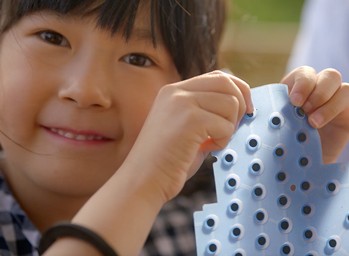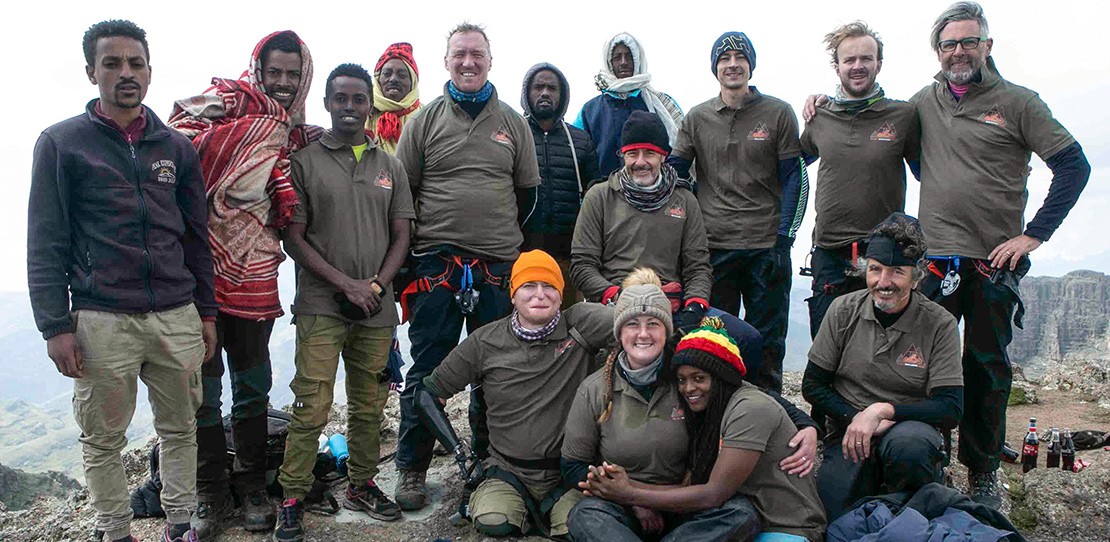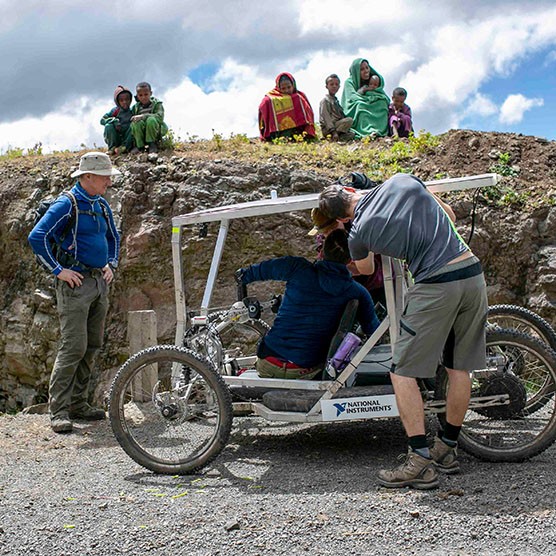
Hope for the Next Generation
In our final episode of Engineering Hope, we’ll continue the story of how David Yi managed his daughter’s devastating medical crisis and how an innovative medical device was essential to the her recovery.
Engineering Through Adversity on Ethiopia's Tallest Mountain

| Photo Credit: Dr. Dave Marshall |
After a 10-day journey through torrential rain and treacherous conditions, Alex Lewis and Emebet Ale Dires reached the summit of Ethiopia’s tallest mountain, Ras Dashen. At 4,550 meters high, making it to the top is an incredible feat in itself, but in their case, it’s a remarkable story of human triumph in the face of adversity.
Alex and Emebet have mobility impairments. Emebet lost both her legs from above her knees after she was hit by a car at age three. Alex contracted an infection at age 33 that led to the amputation of his limbs and part of his face. They accomplished their summit goal with the support of a small team of passionate engineers who designed, built and tested a unique handcycle.
Photo Credit: Ivan Ogilvie
Alex’s life changed dramatically seven years ago after coming down with what he thought was a common cold. The resulting infection led to septicemia, a life-threatening condition. He defied the odds of a 3 percent chance of survival, and although the doctors were able to save his life, they were not able to save his limbs.
After his surgery, Alex’s wife Lucy encouraged him to try new things and resist feeling sorry for himself. Prior to his illness, the most adventurous thing Alex said he did was golf. But with Lucy spurring him on, he grew determined to show his son how to overcome adversity. Four years ago, he started saying yes to just about everything, including skydiving, mountain biking, river rafting in Namibia and sea kayaking around the tip of Greenland.
Photo Credit: HLA/Simon Ratigan
In 2016, Alex met David Collinson, an enthusiastic and generous adventurer who first proposed the idea of summiting Ras Dashen. After Alex agreed to David’s plan, the two men approached the University of Southampton to support their endeavor. Students were then tasked with engineering a vehicle that could withstand Ethiopia’s rough terrain. With that open-ended challenge, the Wild Wheelchairs project was born.
Enter the ambitious engineers who set out to design, build and test something that had never been done before: Christopher Charalambous, Gayan Kahatota Liyanage, Guillaume Henry, Junaid Mahomed, Jin Teh and Tom Parker. They had to overcome many engineering challenges during the project, such as figuring out how the battery would work and how someone without arms could power, steer and brake the vehicle. The group advanced the project with the help of Professor Andrew Cruden and Dr. Lindsay-Marie Armstrong who supervised their work.
Their original design — an electrically-assisted four-wheel drive, double wishbone suspension handcycle — was unveiled at the University’s annual Design Show in June 2018. The handcycle’s custom design included a crank configuration that could power a person up a mountain with simple physical movements. Using CompactRIO and LabVIEW, the team built a central control interface that could resist the vibrations and moisture of Ras Dashen’s ecosystem. CompactRIO controlled an electrical system, which included brushless hub motors to provide the torque needed to traverse a steep mountain incline and reach speeds up to 30 mph.
Extensive coding and testing continued over subsequent months. Tests were supported by Dr. Clint Styles, other technical staff at the University and NI. Safety was paramount to ensure that Alex was secure and protected while using the handcycle. With a background in cycling, Dr. David Marshall, an aerospace engineering graduate and manager of the University’s wind tunnels, got involved to get the handcycle over the last hurdles. NI worked closely with the engineering team to test and optimize the handcycle.

Alex and David Collinson were introduced to Emebet midway through the Wild Wheelchairs project and invited her to join them on their expedition. Emebet loved playing basketball in her wheelchair and was excited to take on a new challenge.
When the time came to make the journey to Ethiopia, David Marshall and Tom Parker accompanied Alex. The handcycle was expected to make a relatively simple point-to-point flight from England to Ethiopia, but not everything went according to plan. The handcycle was rejected for commercial flight at the airport because of its batteries and had to be crated across Europe and then loaded on a freight plane in the Netherlands, where it eventually arrived in Addis Ababa. From there, the handcycle was driven for 12 hours to Bahir Dar to begin the ascent.
They faced 10 days of heavy rain and inclement cold weather, which Tom referred to as “a total mud bath.” Still, they persevered, and in one particularly exuberant moment, Emebet powered her handcycle without much assistance, past lorries and busses stuck in the mud. Along the way, the engineers had to make adaptations to improve the performance of both handcycles, occasionally working in the dark with headlamps.
The expedition also featured many poignant moments. On market day in the village of Cheru Leba, the team attracted a great deal of attention, with Alex and Emebet greeting people and shaking many hands. During a later visit to a small settlement, dozens of children followed the expedition team for several kilometers. On the way out of town, they met a man in a wheelchair who came out into the street. They had a chance to tell him and many others about their plans to enhance the local wheelchair factory and help people with mobility impairments in the region. Alex was especially moved by the outpouring of encouragement and the people he engaged with along the way. To him, these were the defining moments of the expedition. “It was never about getting to the top of the mountain,” he said. “It was about engaging with people who need help.”
While moving up the mountain, a downpour forced them to find an alternate route since the path they planned to take had been washed away. Once they reached the base of the summit, the team had a narrow window of time to reach the top. Alex was assisted up the craggy face of the final plateau by a small team with ropes. He then crawled the last 20 meters where he had an emotional meeting at the top of the mountain with Dr. Geoff Watson, the expedition’s medical officer and surgeon who originally saved Alex’s life. Emebet soon crawled her way to the top, too, hauling herself over the cliff face with just her arms. “I was so excited and proud,” she said.
I couldn’t believe we’d made it. It took so many people to get us to that point. With the right people, everything is possible.
Wild Wheelchairs Cofounder
The Wild Wheelchairs team wants to create a lasting change for the communities they visit. They raised money to finance the construction and enhancement of a wheelchair manufacturing facility in Ethiopia. They’re also intent on creating a sustainable infrastructure to enable ongoing collaborations to stay abreast of evolving mobility technology. They’re exploring how they can manufacture additional wheelchairs using local materials and export them throughout Africa.
Photo Credit: Ivan Ogilvie
Alex is committed to nurturing relationships on the ground to truly understand the unique challenges individuals with mobility impairments face. In his words, rather than “walking a mile in their shoes, you need to wheel a mile in their chair” to know what they’re going through in their communities. He hopes this work will transform the lives of hundreds of people with mobility impairments living in Ethiopia. Emebet had this reflection: “This experience has helped me talk about myself, be a role model to others and improve the community’s perception of people with disabilities in Ethiopia.”
Photo Credit: Dr. Dave Marshall
The team is planning another ambitious expedition, this time in a very different climate. Wild Wheelchairs 2, The Gobi 500, will feature Alex and the rest of the team attempting to ride 500 kilometers in 10 days through the Gobi Desert with a solar powered handcycle. A second team of students expanded the original design; it’s been fine-tuned to navigate the challenges of the new terrain. They swapped the suspension for air-shocks; added panels to minimize sand in the drive systems, electronics and switch gear; and changed the length of the wishbone to accommodate the 4-inch-wide tires that will help the cycle “float” over the sand rather than sink. Testing has already begun.
The expedition was originally planned for July 2020, but due to the COVID-19 pandemic, it’s now slated for the summer of 2021.
With the support of the engineers at the University of Southampton, Alex isn’t stopping there. He aims to ride across the Atlantic in 2022 with a handcycle system in a boat.
For now, Alex’s life looks like many others. He’s staying home with his wife, helping his nine-year-old son Sam navigate the challenges of virtual school and attending meetings online as he works from home. In addition to planning his next expeditions, he devotes time as a motivational speaker, inspiring others to overcome adversity and accomplish their life goals.
He shared that people often think that what happened to him was a terrible thing. He wants people to know that it was not. “I’ve done more in the last six years than I had in the 33 years before this happened. It hasn’t damaged my life; it’s enhanced it. As my son grows up, he will see that my disability never got in my way.”
Photo Credit: Dr. Dave Marshall